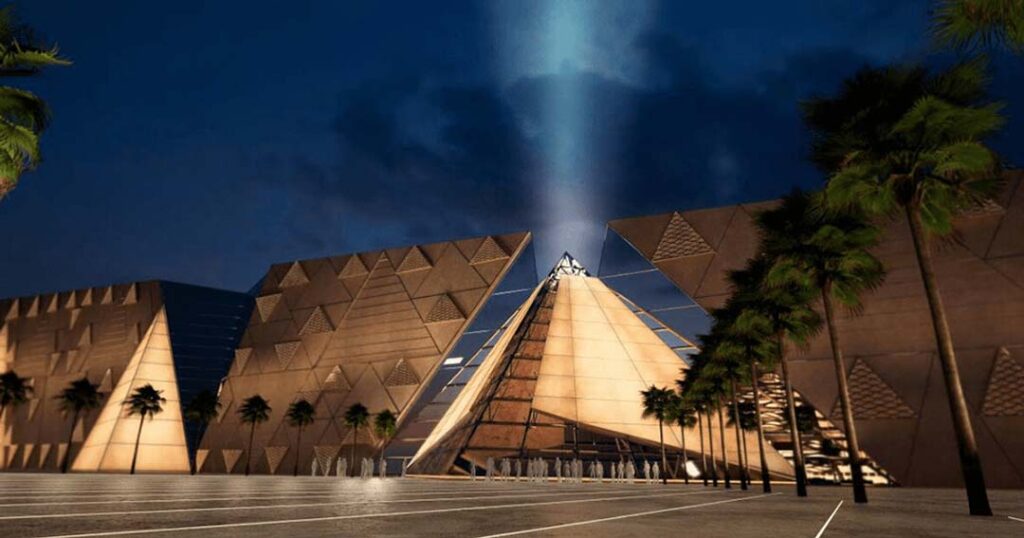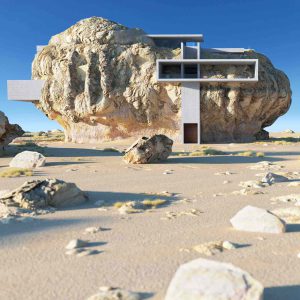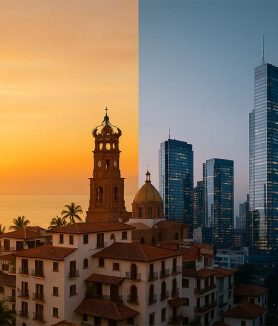This year, at last, the Grand Egyptian Museum (GEM) will be inaugurated, after having postponed its opening on several occasions, such as in the 2011 revolution and in the covid-19 pandemic.
The great work is located on the outskirts of Cairo, just two kilometers from the Giza plateau and offers unbeatable views of the pyramids of Khafre, Cheops and Micerinos. The GEM had been planned since 1992 and work began in 2003 after the UNESCO-sponsored tender was won by Dublin-based architects Heneghan Peng.
 The great achievement is that the building manages to merge with the desert landscape. It is three floors high and its façade is decorated with pyramidal motifs that evoke Ancient Egypt. As for the interior, the exhibition space is 24,000 m², which is equivalent to six football fields. The space will contain more than 100,000 ancient artifacts, most of which have never before been seen by the public, making it the world’s largest museum of Egyptology. As soon as visitors enter the compound, they are greeted by a 12m-tall statue of King Ramses II, which was moved here from Cairo, where it stood in a square near the train station. And as soon as you look up you’ll see the monumental staircase lined with 60 statues, leading to a grand glass foyer. It is from there that a spectacular view of the three pyramids of Giza unfolds, tombs of the pharaohs Khufu, Khafra and Menkaura.
The great achievement is that the building manages to merge with the desert landscape. It is three floors high and its façade is decorated with pyramidal motifs that evoke Ancient Egypt. As for the interior, the exhibition space is 24,000 m², which is equivalent to six football fields. The space will contain more than 100,000 ancient artifacts, most of which have never before been seen by the public, making it the world’s largest museum of Egyptology. As soon as visitors enter the compound, they are greeted by a 12m-tall statue of King Ramses II, which was moved here from Cairo, where it stood in a square near the train station. And as soon as you look up you’ll see the monumental staircase lined with 60 statues, leading to a grand glass foyer. It is from there that a spectacular view of the three pyramids of Giza unfolds, tombs of the pharaohs Khufu, Khafra and Menkaura.
 Also, the GEM will feature the largest collection of Tutankhamun’s treasures, which will be seen together for the first time, which is approximately 5,000 pieces first unearthed in November 1922 by Howard Carter in the Valley of the Kings in Luxor. These include gold masks, sarcophagi, gold beds and chariots, mother-of-pearl jewelry inlaid with precious stones. All the king’s treasures, untouched for 3,000 years, will be displayed behind glass cases in the spacious gallery.
Also, the GEM will feature the largest collection of Tutankhamun’s treasures, which will be seen together for the first time, which is approximately 5,000 pieces first unearthed in November 1922 by Howard Carter in the Valley of the Kings in Luxor. These include gold masks, sarcophagi, gold beds and chariots, mother-of-pearl jewelry inlaid with precious stones. All the king’s treasures, untouched for 3,000 years, will be displayed behind glass cases in the spacious gallery.
Another very important piece that will be exhibited is the famous solar boat of Pharaoh Khufu, which was supposed to transport souls to the afterlife. It is 42m long, weighs 20 tons and is 4600 years old, it is the largest wooden boat in the world. It was discovered in 1954, near the burial chambers of the Khufu pyramid.
The Museum intends to differentiate itself from others by showing the context of the exhibited heritage pieces, allocating an important part of its space to the recreation of the different scenarios where the archaeological remains were found by means of models, maps and audiovisual material, which will allow visitors to visitors to know these places in greater depth.
In addition to being a museum, the GEM also aims to become a cultural and tourist complex. The building will contain shops, restaurants, a conference center and a cinema. The objective? Inject new life into Egyptian tourism, a mainstay of the country’s economy that has never fully recovered after the political unrest of 2011. The new museum will attract six million visitors each year, who will be able to visit both the museum and the pyramids of Giza with a single ticket.
So all that remains to be known is the exact date that the Grand Egyptian Museum will open its doors to the public! Many dates have been rumored, but none confirmed. The opening festivities, which should be spectacular, are likely to kick off in the fall around the centenary celebrations of the excavation of Tutankhamun’s tomb.












